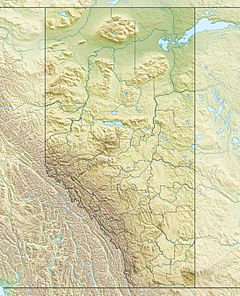Mount Olive (Canadian Rockies) facts for kids
Quick facts for kids Mount Olive |
|
|---|---|

Mount Olive (left) with Saint Nicholas Peak (right) seen from Bow Lake
|
|
| Highest point | |
| Elevation | 3,126 m (10,256 ft) |
| Prominence | 146 m (479 ft) |
| Geography | |
| Location | Alberta / British Columbia Canada |
| Parent range | Park Ranges Canadian Rockies |
| Topo map | NTS 82N/09 |
| Climbing | |
| First ascent | 1927 M. Cropley, F.A. Gambs, N.L. Goodrich, L. Grassi |
Mount Olive is a mountain located in the beautiful Canadian Rockies. It sits right on the border between the Canadian provinces of Alberta and British Columbia. This means it's part of two amazing places: Banff National Park and Yoho National Park.
The mountain is found on the eastern edge of the Wapta Icefield, which is a huge area of ice and glaciers. It's also part of the Waputik Mountains. Mount Olive was named in 1898 by H.B. Dixon, who chose the name after his wife, Olive.
What is Mount Olive Made Of?
Mount Olive is mostly made of sedimentary rock. Imagine tiny bits of sand, mud, and even old shells. These pieces settled at the bottom of ancient seas over millions of years. Slowly, they hardened into layers of rock.
These rocks formed during a very long time, from the Precambrian to the Jurassic periods. Later, during a huge mountain-building event called the Laramide orogeny, these rock layers were pushed up. This powerful force created the tall mountains we see today, including Mount Olive.
Weather at Mount Olive
The weather at Mount Olive is known as a subarctic climate. This means it has very cold and snowy winters. The summers are usually mild, not too hot.
Temperatures can drop really low, sometimes below -20 °C (which is -4 °F). With the wind, it can feel even colder, sometimes below -30 °C (which is -22 °F). So, it's a very chilly place for most of the year!



